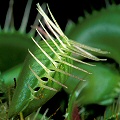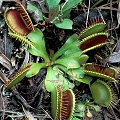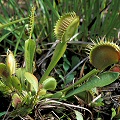Q: Exactly how does a Venus flytrap's leaves close so fast?
A: Clearly, judging by e-mails asking for details, my
general discussion of Dionaea leaf closure
is not quite sufficient for your
voracious curiosities. Either that, or you students are asking me to write your homework for you.
OK, so here are more details about leaf closure. But be warned that botanists
do not really have a satisfactory and comprehensive understanding of how
Venus flytraps close their leaves so fast. That is not to say that
scientists are so baffled that they think that the plants have nervous systems and so
forth. Rather, scientists just have not yet figured everything out. (This, of
course, is what makes science so interesting!)

Phase I

Phase II

Phase III
As far as I understand it, there are three phases of Dionaea leaf closure:
- I: Initial Snap
- This is the very fast, snapping closure that catches bugs in such an exciting way. It takes less than a second.
- II: Tightening Phase
- This is the phase in which the leaves slowly tighten against each other making a cage from which bugs cannot escape. This takes about 30 minutes. Many of the traps in the photo to the right, captioned "Phase II", have finished this phase.
- III: Sealing Phase
- This is the stage in which the seal is completed. The marginal spines are pulled away from each other, so they are no longer crossing each other. Put your hands together as in prayer, spread the fingers as widely as you can, then reflex your fingers (as if the fingers of your opposing hands repelled each other, and you can see the end configuration of the sealing phase. The far-right trap in the photograph captioned "Phase III" is in this stage.
All the phases of Dionaea leaf closure are caused by changes in the curvature of the leaf surface.
These changes in curvature are
achieved by differences in the size of the leaf on the inner surface vs the outer surface. Here is what I mean. Hold your arm up
in front of you. Poise it with your upper arm horizontal, and your forearm vertical (like you were making a muscle, to show off
your extraordinary bicep development). (Incidentally, this is one of those stances that Prince was referring to when he sings
"Animals strike curious poses". FYI.) Look at your vertical forearm. Imagine if the skin on the left side was super strong and
was shrinking. At the same time, imagine the skin on the right side of your arm was getting looser (maybe because it was growing).
If the bones of your forearm were all rubbery, your forearm would bend to the left, towards the shrinking skin. Ychh.
This is basically what is happening when any carnivorous plant does some kind of leaf or tentacle flexure. The plant tissues
on the opposing leaf surfaces change in relative size. There are three main mechanisms for this: acid growth, growth by cell
division, and leaf turgor.
Acid growth is a phenomenon in which the release of acidic compounds in the leaf tissues result in the loosening of some of the
fibers in cell walls. Because of this loosening, the cells are free to expand. This is acid growth.
The enlarging (growing) cells make one side of the leaf bigger
than the other side, and the leaf flexes away from the side experiencing the acid growth. Acid growth is responsible for phase I leaf
closure that I described above.
Turgor pressure leaf movement is an osmotic effect, in which an ion (in the case of
Dionaea, K+)
released into the leaf tissues makes the cells on one surface of the leaves wilt. This makes the wilting surface slightly smaller
than the unwilted, opposing leaf surface. The leaf curls towards the wilted side. Turgor pressure effects are apparently at least partly
responsible
for phases II and III that I described above.
Growth by cell division is another way of increasing the amount of tissue in
parts of a leaf or tentacle. It is a relatively slow phenomenon, so
does not contribute to particularly rapid leaf motion. It may have a role in Dionaea leaf actions in
phases II and III.
Is that detailed enough for you?
Page citations: Bailey, T.S. 2008; Bailey, T. & McPherson, S. 2012; Fagerberg, W.R. 2002; Fagerberg, W.R. & Allain, D. 1991; Fagerberg, W.R. & Howe, D.G. 1996;
Williams, S.E. 2002.